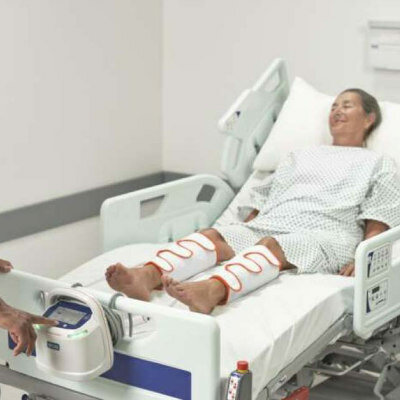Dilation Device Treats Persistent Eustachian Tube Dysfunction
|
By HospiMedica International staff writers Posted on 26 Sep 2016 |

Image: Eustachian tube balloon dilation with the Aera system (Photo courtesy of Dr. Jeeve Kanagalingam).
A novel dilation system uses a small balloon to treat persistent Eustachian tube dysfunction (ETD), a condition in which pain and other sensations affect the ear.
The Aera Eustachian tube system consists of a balloon catheter that is inserted through the patient’s nose into the Eustachian tube. After insertion, the balloon is inflated for two minutes to open up a pathway for mucus and air to flow through, in order to restore proper function and reduce pressure, pain, or clogged or muffled sensations in the ear. After the Eustachian tube is dilated, the balloon is deflated and removed. The most common adverse events are small tears of the lining of the Eustachian tube, minor bleeding, and worsening of ETD.
In a study involving 299 patients with chronic ETD, 52% of the patients treated with the Aera system had a subsequent normal functioning range as measured by a tympanogram, a method used to measure mobility of the ear drum and pressure inside the ear. The positive results were fourfold higher than in patients treated with conventional medical management using nasal sprays. The Aera system is a product of Acclarent (Menlo Park, CA, USA), and has been approved by the U.S. Food and Drug Administration (FDA).
“The Aera Eustachian tube balloon dilation system is a new treatment option for patients with ETD symptoms,” said Malvina Eydelman, MD, director of the ophthalmic & ENT device division at the FDA Center for Devices & Radiological Health (CDRH). “The Eustachian tube supports hearing by maintaining pressure inside the ear. Restoring function to this important part of the middle ear may provide relief from the pain, discomfort and sensation of ear fullness or blockage associated with ETD.”
“The Acclarent Aera offers a minimally-invasive and promising option for patients suffering from Eustachian tube dysfunction," said Juha Silvola, MD, PhD, a consultant in Otology-Otoneurology at Oslo University Hospital (Norway). “In my initial experiences with the Aera, the device enabled me to safely and successfully dilate my patients' Eustachian tubes.”
The Eustachian tube is a narrow passage leading from the pharynx to the cavity of the middle ear, permitting the equalization of pressure on each side of the eardrum. It is normally filled with air and helps maintain equal pressure inside the ear with the surrounding environment by periodically opening and closing, like a valve. If this function is impaired, as is the case with ETD, it results in discomfort, impaired hearing, persistent ear infections, ringing in the ears (tinnitus) or other symptoms.
Related Links:
Acclarent
Oslo University Hospital
The Aera Eustachian tube system consists of a balloon catheter that is inserted through the patient’s nose into the Eustachian tube. After insertion, the balloon is inflated for two minutes to open up a pathway for mucus and air to flow through, in order to restore proper function and reduce pressure, pain, or clogged or muffled sensations in the ear. After the Eustachian tube is dilated, the balloon is deflated and removed. The most common adverse events are small tears of the lining of the Eustachian tube, minor bleeding, and worsening of ETD.
In a study involving 299 patients with chronic ETD, 52% of the patients treated with the Aera system had a subsequent normal functioning range as measured by a tympanogram, a method used to measure mobility of the ear drum and pressure inside the ear. The positive results were fourfold higher than in patients treated with conventional medical management using nasal sprays. The Aera system is a product of Acclarent (Menlo Park, CA, USA), and has been approved by the U.S. Food and Drug Administration (FDA).
“The Aera Eustachian tube balloon dilation system is a new treatment option for patients with ETD symptoms,” said Malvina Eydelman, MD, director of the ophthalmic & ENT device division at the FDA Center for Devices & Radiological Health (CDRH). “The Eustachian tube supports hearing by maintaining pressure inside the ear. Restoring function to this important part of the middle ear may provide relief from the pain, discomfort and sensation of ear fullness or blockage associated with ETD.”
“The Acclarent Aera offers a minimally-invasive and promising option for patients suffering from Eustachian tube dysfunction," said Juha Silvola, MD, PhD, a consultant in Otology-Otoneurology at Oslo University Hospital (Norway). “In my initial experiences with the Aera, the device enabled me to safely and successfully dilate my patients' Eustachian tubes.”
The Eustachian tube is a narrow passage leading from the pharynx to the cavity of the middle ear, permitting the equalization of pressure on each side of the eardrum. It is normally filled with air and helps maintain equal pressure inside the ear with the surrounding environment by periodically opening and closing, like a valve. If this function is impaired, as is the case with ETD, it results in discomfort, impaired hearing, persistent ear infections, ringing in the ears (tinnitus) or other symptoms.
Related Links:
Acclarent
Oslo University Hospital
Latest Surgical Techniques News
- Minimally Invasive Endoscopic Surgery Improves Severe Stroke Outcomes
- Novel Glue Prevents Complications After Breast Cancer Surgery
- Breakthrough Brain Implant Enables Safer and More Precise Drug Delivery
- Bioadhesive Sponge Stops Uncontrolled Internal Bleeding During Surgery
- Revolutionary Nano Bone Material to Accelerate Surgery and Healing
- Superior Orthopedic Implants Combat Infections and Quicken Healing After Surgery
- Laser-Based Technique Eliminates Pancreatic Tumors While Protecting Healthy Tissue
- Surgical Treatment of Severe Carotid Artery Stenosis Benefits Blood-Brain Barrier
- Revolutionary Reusable Duodenoscope Introduces 68-Minute Sterilization
- World's First Transcatheter Smart Implant Monitors and Treats Congestion in Heart Failure
- Hybrid Endoscope Marks Breakthrough in Surgical Visualization
- Robot-Assisted Bronchoscope Diagnoses Tiniest and Hardest to Reach Lung Tumors
- Diamond-Titanium Device Paves Way for Smart Implants that Warn of Disease Progression
- 3D Printable Bio-Active Glass Could Serve as Bone Replacement Material
- Spider-Inspired Magnetic Soft Robots to Perform Minimally Invasive GI Tract Procedures
- Micro Imaging Device Paired with Endoscope Spots Cancers at Earlier Stage
Channels
Critical Care
view channel
Light-Based Technology to Measure Brain Blood Flow Could Diagnose Stroke and TBI
Monitoring blood flow in the brain is crucial for diagnosing and treating neurological conditions such as stroke, traumatic brain injury (TBI), and vascular dementia. However, current imaging methods like... Read more
AI Heart Attack Risk Assessment Tool Outperforms Existing Methods
For decades, doctors have relied on standardized scoring systems to assess patients with the most common type of heart attack—non-ST-elevation acute coronary syndrome (NSTE-ACS). The GRACE score, used... Read morePatient Care
view channel
Revolutionary Automatic IV-Line Flushing Device to Enhance Infusion Care
More than 80% of in-hospital patients receive intravenous (IV) therapy. Every dose of IV medicine delivered in a small volume (<250 mL) infusion bag should be followed by subsequent flushing to ensure... Read more
VR Training Tool Combats Contamination of Portable Medical Equipment
Healthcare-associated infections (HAIs) impact one in every 31 patients, cause nearly 100,000 deaths each year, and cost USD 28.4 billion in direct medical expenses. Notably, up to 75% of these infections... Read more
Portable Biosensor Platform to Reduce Hospital-Acquired Infections
Approximately 4 million patients in the European Union acquire healthcare-associated infections (HAIs) or nosocomial infections each year, with around 37,000 deaths directly resulting from these infections,... Read moreFirst-Of-Its-Kind Portable Germicidal Light Technology Disinfects High-Touch Clinical Surfaces in Seconds
Reducing healthcare-acquired infections (HAIs) remains a pressing issue within global healthcare systems. In the United States alone, 1.7 million patients contract HAIs annually, leading to approximately... Read moreHealth IT
view channel
Printable Molecule-Selective Nanoparticles Enable Mass Production of Wearable Biosensors
The future of medicine is likely to focus on the personalization of healthcare—understanding exactly what an individual requires and delivering the appropriate combination of nutrients, metabolites, and... Read moreBusiness
view channel
Philips and Masimo Partner to Advance Patient Monitoring Measurement Technologies
Royal Philips (Amsterdam, Netherlands) and Masimo (Irvine, California, USA) have renewed their multi-year strategic collaboration, combining Philips’ expertise in patient monitoring with Masimo’s noninvasive... Read more
B. Braun Acquires Digital Microsurgery Company True Digital Surgery
The high-end microsurgery market in neurosurgery, spine, and ENT is undergoing a significant transformation. Traditional analog microscopes are giving way to digital exoscopes, which provide improved visualization,... Read more
CMEF 2025 to Promote Holistic and High-Quality Development of Medical and Health Industry
The 92nd China International Medical Equipment Fair (CMEF 2025) Autumn Exhibition is scheduled to be held from September 26 to 29 at the China Import and Export Fair Complex (Canton Fair Complex) in Guangzhou.... Read more














